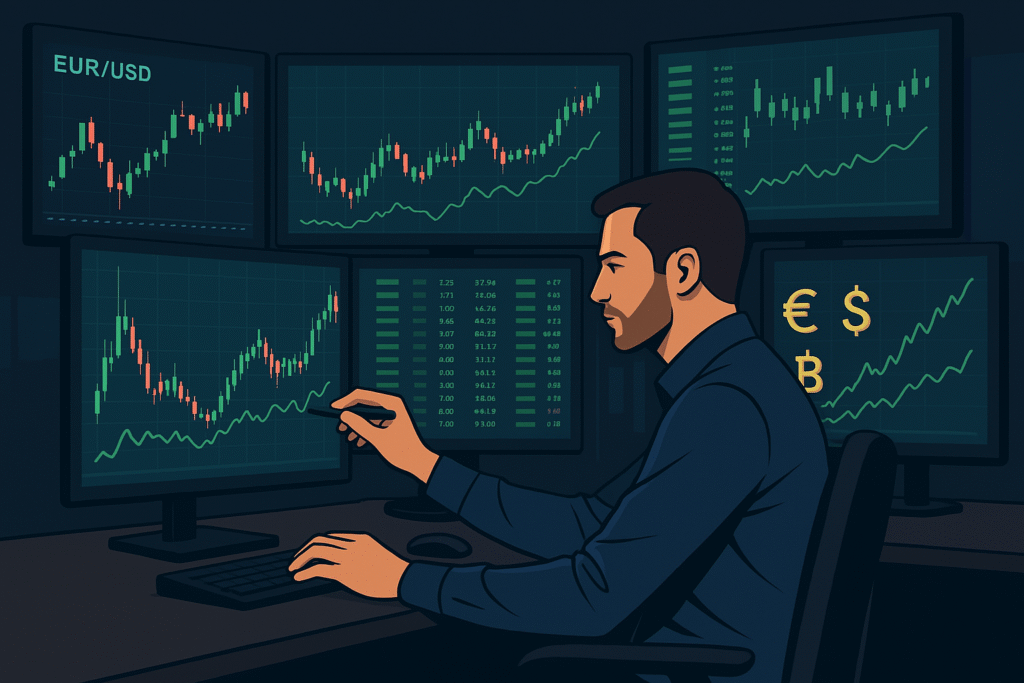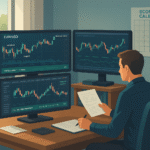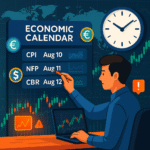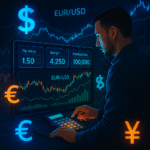In the fast-paced world of trading, success isn’t just built on technical indicators and market timing — it’s forged in mindset, discipline, and adaptability. While trends evolve year after year, one constant remains: the trader who thrives is the one who learns, applies, and adapts relentlessly.
Whether you’re navigating forex markets, riding the crypto waves, or making informed moves in commodities and indices, this post unpacks what modern traders are doing differently in 2025, and what lessons from the last few years remain timeless.
⚡ A Look at Current Trading Trends (2025)
Before we dive deep into mindset, let’s consider today’s landscape. A successful trader in 2025 should be aware of:
- Global Currency Volatility: Interest rate disparities and inflation have kept pairs like EUR/USD and GBP/USD bouncing wildly. Traders are leveraging volatility with smart stop-loss placements and using technical setups like Bollinger Bands to predict swings.
- AI Integration: Platforms like OctaTrader and Meta AI Trade use artificial intelligence to refine entry and exit points. Even beginner traders now have access to algorithmic tools once reserved for institutional pros.
- Green Commodities in Focus: With the global push toward renewable energy, metals like lithium, copper, and nickel have become high-interest assets. Traders aren’t just watching gold anymore — they’re stalking the next surge in EV-related commodities.
- Geopolitical Risk Hedging: Global tensions, particularly between the U.S. and China, continue to rattle markets. Smart traders diversify portfolios, apply hedging strategies, and monitor news cycles closely.
- Southeast Asia’s Ascendancy: New players like Indonesia and Vietnam are reshaping trade flows, making regional analysis and currency pairing strategies increasingly important.
📚 Lessons From 2022 to 2024: What the Past Teaches Us
As markets evolve, reflecting on the past reveals valuable patterns. From 2022–2024, traders witnessed:
- Post-COVID Recovery: 2022 showed us how pent-up demand can inflate markets — but also how swiftly that inflation can sour trades.
- Crypto Volatility: Retail rushes in 2022 and dramatic dips in 2023 reminded us that fundamentals still matter. Traders today are more cautious, often pairing crypto trades with long-term holds or stablecoin balances.
- Rise of Options Trading: By 2024, options saw a 317% volume increase over 8 years, with retail investors making up 30%. Learning options became a strategic edge.
- AI Algorithms in the Spotlight: The shift to AI wasn’t hype. Traders who embraced machine learning saw improvements in trade consistency and emotional detachment.
- ETF Inflows and Sector Rotation: From energy to tech, traders followed interest rate cycles — not just news hype — to adjust sector exposure and risk.
These trends laid the foundation for smarter strategies today. Traders who survived and thrived during those years usually did one thing consistently: they learned from every win and loss.
🧠 The Psychology of Winning Traders
Technical skills get you in the game — but psychology determines how long you last. Here’s how the best traders think:
1. Embrace Probability, Not Perfection
No strategy guarantees success. But with well-calculated risk-reward ratios, even a 60% win rate can lead to profitability. The key is consistent execution and acceptance of losing trades as part of the process.
2. Discipline Beats Drama
Emotional traders chase losses, double down, and panic. Disciplined traders stick to a trading plan, set logical stop-loss levels, and avoid impulsive reactions. Tools like trading journals or accountability groups can reinforce discipline.
3. Resilience Matters More Than Intelligence
Great traders aren’t those who never lose — they’re the ones who bounce back smarter after each setback. Whether it’s a blown account or market crash, resilience ensures you learn, rebuild, and return with clarity.
4. Mindful Risk Management
Managing risk isn’t just about stop-losses. It’s knowing when not to trade, what percentage of capital to risk per position, and how to balance between aggressive and conservative approaches.
5. Continual Learning
Top traders are perpetual students. They read market reports, join forums, backtest strategies, and refine systems regularly. In a market where conditions change rapidly, static knowledge doesn’t cut it.
🛠️ Practical Strategies Traders Use Today
Now, let’s get actionable. Here are some top methods successful traders use in 2025:
- Breakout Strategies with Confirmation: Use multiple timeframes (e.g., 4H + Daily) to confirm breakout levels. Add RSI or MACD to validate momentum.
- Swing Trading with News Catalysts: Combine economic reports and geopolitical events with technical setups for high-probability trades.
- Smart Scaling: Instead of going all-in, traders use position scaling — entering partially at key zones and adding on strength confirmations.
- Dollar-Cost Averaging (DCA) for Volatile Assets: In crypto or emerging stocks, traders reduce timing risks by investing steadily over time.
- Risk-Reward Filter: Many traders now won’t take trades unless the potential reward is at least twice the potential risk — ensuring long-term profitability even with mixed results.
💬 Final Thoughts: Teach, Trade, Transform
As you guide your audience through the world of trading, remind them: it’s not just about making money. It’s about building a system that fits their personality, schedule, and goals.
Some will love scalping in forex before work; others will prefer swing trading stocks over the weekend. What matters is helping them find what works — and giving them tools and truths that go beyond flashy setups and empty promises.
Today’s markets reward those who respect data and learn from history. They favor the patient, the consistent, and the thoughtful trader. And as a mentor, your job is not just to teach — it’s to transform how your students think about markets, risk, and themselves.
Let’s keep building traders who not only chase profit — but master the process.




